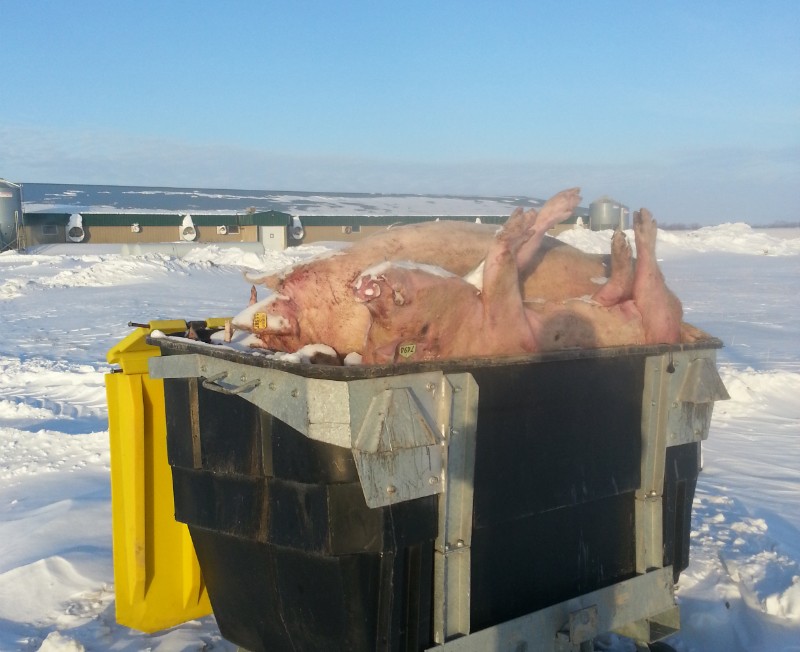I took a picture of a bin full of dead, frozen pigs. It’s not an indictment of the hog industry. It’s not strong commentary. It’s not even an expose of a heinous act. It is, however, a bewildering tableaux to see so close to a highway. And, it is a stupid thing for a farm to do. I grew up on a farm, one that had hogs for many years. I chored them, daily, and we had hundreds. Some even died, occasionally. And we did — gasp! — have to dispose of the bodies. But we did so differently.
What is shocking about this, especially to someone who immediately got over the fact that a bin packed full of dead animals was set down about 30-feet from a busy highway, is that the farmer or farm-hand who chose this unfortunate location to set down the coffin was ensuring an already beleaguered industry stays on its knees. High feed costs and low meat prices have forced the closure of many barns across the Prairies.
Surprisingly, the province of Manitoba does have a resource for farmers needing to dispose of their dead animals. And, what it says is just as interesting, as is what it does not say, and what is presumed. Relating to the proper disposal of sheep:
“Location of a composter should take the farm residence and any neighbouring residences into account. While offensive odours are not usually generated in the composting process, the handling of dead livestock and compost on a daily basis may not be aesthetically pleasing.”
Indeed, it is not aesthetically pleasing, but what’s notable here is that, according to the province, the major consideration when putting dead livestock near the highway is how it looks.
From the disposal of mortalities section of the environmental act’s livestock manure and mortalities management regulation pdf:
“No person shall keep mortalities in or at an agricultural operation unless the mortalities are kept: (a) in a secure storage room, covered container or secure location; and (b) continually frozen or refrigerated, if not disposed of within 48 hours after death.”
I doubt the frozen pigs pictured above were kept there for composting purposes, but, if they were, this applies:
“No person shall compost livestock mortalities on the property of an agricultural operation unless the composting site is located at least 100 m from (i) any surface watercourse, sinkhole, spring or well, and (ii) the operation’s boundaries.”
Manitoba hog farmers, already dealing with plummeting market prices that are forcing them to make a battery of eleventh-hour decisions, have been raked over the coals. Not by the media (though some organizations do seem quick to portray most things rural in a negative, facile light, cough, CBC, cough), but by a groundswell of ignorance over rural practices and a naive idealism towards where that bacon you love — I love — comes from.
The definition of a factory farm is conveniently loose enough to include almost every traditional-looking barn, hog or other. And, the people running those barns are often written-off as thoughtless and cruel, patronized to as simple, or vilified as corporate/unfeeling. Menno and Bernie Bergen’s barn near Winkler, Man., made news last year when reports streamed in that the hogs were being euthanized inhumanely. Death is death, most get that. But there is so much more to the story that CBC News chose not to cover, or, more likely, had no staff knowledgable in rural issues. Instead, the public is given just enough information to hate and judge.
Hog farmers respect life, and they do so within a lifestyle that allows them to hunt and trap. I can’t comment on the practices of the Bergen barn, but I can comment on what I know from the sample of farmers I have come in contact with.
“Producers are shocked by such actions and would hope the public would believe that is not reflective of how we raise our animals on a regular basis,” Manitoba Pork Council’s Andrew Dickson told CBC News in response to last year’s euthanized piglets.
I think raising hogs or any other livestock in a large, outdoor environment is ideal, but, simply put, if our collective appetite for pork remains as strong as it currently is, this will not happen.
The distance between that Hwy 305 sighting and Winnipeg is not just geographical. Consider the image to this story an inkblot test. What do you see? I see unfortunate placement, that’s it.
Spectator Tribune is an alternative media source for the Prairies, and our hope is to cover issues relating to more than just city life. Consider this such an attempt.
_____
Toban Dyck is a writer/editor/farmer. Follow him @tobandyck.
For more follow us @spectatortib.
